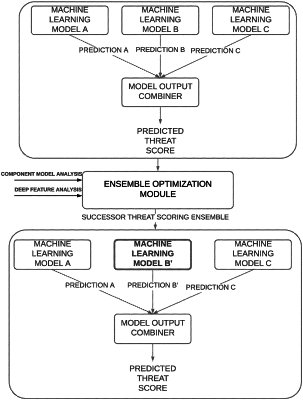| CPC G06F 21/55 (2013.01) [G06N 5/04 (2013.01); G06N 20/20 (2019.01); G06F 2221/034 (2013.01)] | 20 Claims |

|
1. A method for accelerated anomaly detection and replacement of an anomaly-experiencing machine learning-based ensemble, the method comprising:
identifying, by one or more computers, a machine learning-based digital threat scoring ensemble having an anomalous drift behavior in digital threat score inferences computed by the machine learning-based digital threat scoring ensemble for a target period;
executing, based on the identifying, a tiered anomaly evaluation for the machine learning-based digital threat scoring ensemble, wherein the tiered anomaly evaluation includes:
(a) identifying at least one machine learning-based model of the machine learning-based digital threat scoring ensemble contributing to the anomalous drift behavior, and
(b) identifying at least one feature variable of the at least one machine learning-based model contributing to the anomalous drift behavior;
generating a potential successor machine learning-based digital threat scoring ensemble to the machine learning-based digital threat scoring ensemble based on the tiered anomaly evaluation, wherein the potential successor machine learning-based digital threat scoring ensemble mitigates the anomalous drift behavior; and
replacing the machine learning-based digital threat scoring ensemble with the potential successor machine learning-based digital threat scoring ensemble based on one or more ensemble metrics computed for the potential successor machine learning-based digital threat scoring ensemble satisfying one or more efficacy benchmarks.
|